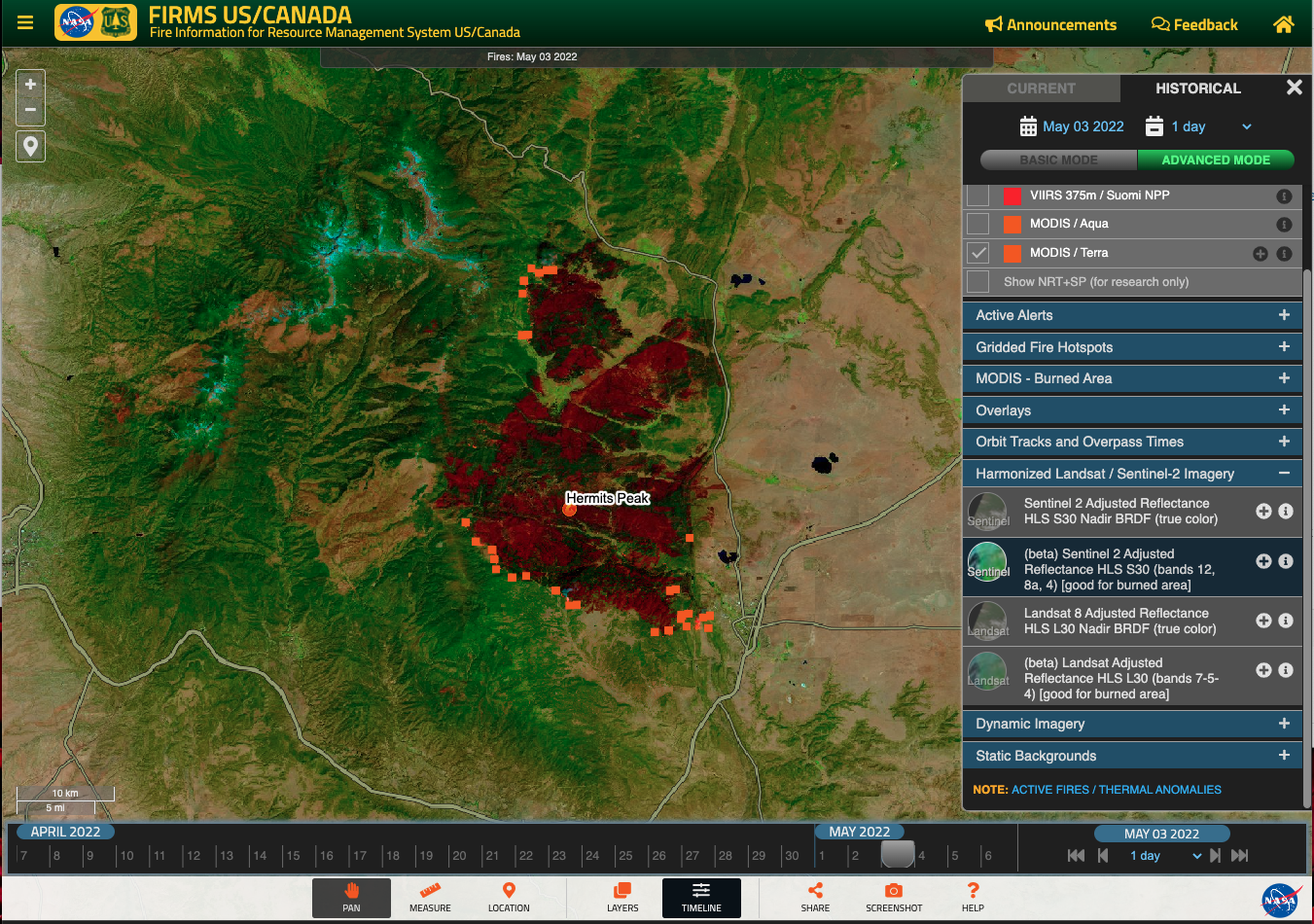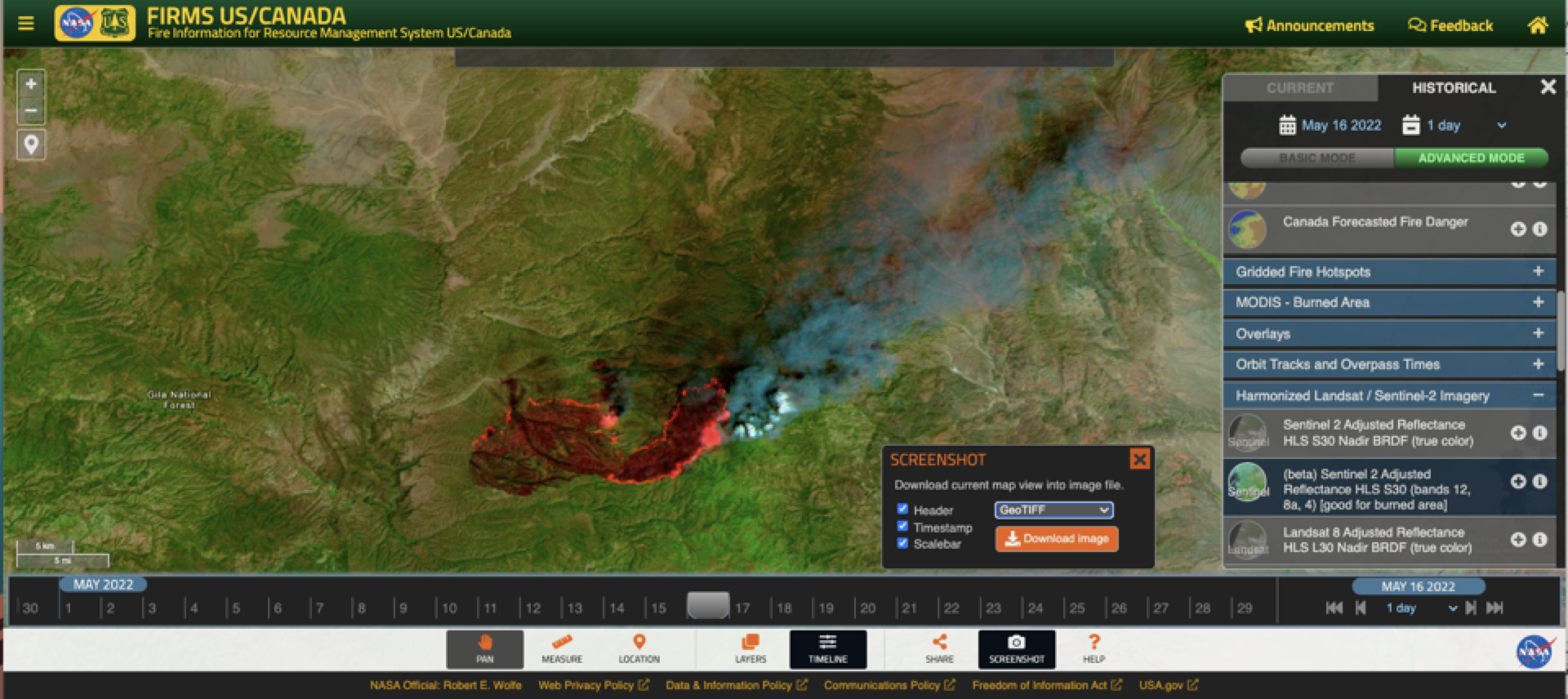
In collaboration with NASA's IMPACT project, dynamic false color imagery is now available through FIRMS to help better delineate burned areas.

A screenshot from FIRMS US/Canada displaying the Sentinel-2 Adjusted Reflectance Harmonized Landsat Sentinel (HLS) using bands 12-8a-4. It shows the Hermits Peak Fire in New Mexico, USA as captured on 3 May 2022. In this image, the burned areas appear in brick red and are overlain with active fire pixels from MODIS and VIIRS. (Link to view in FIRMS)
FIRMS has recently integrated an additional Harmonized Landsat/Sentinel-2 (HLS) Imagery product. The Reflectance (Bands 7-5-4) layer from Landsat 8/OLI and (Bands 12, 8a, 4) from Sentinel 2A and 2B are false color composite (FCC) images that allow us to visualize wavelengths that the human eye cannot see (i.e. short wave infrared and near infrared). Burned areas appear almost brick red making it easier to see fire affected areas and water is very dark, almost black, which makes it much easier to see lakes or flooded lands.
Unlike other satellite imagery layers in FIRMS, which are provided through NASA GIBS, the beta version HLS False Color Composite Imagery (Bands 7-5-4 for Landsat and Bands 12, 8a, 4 for Sentinel 2A and 2B), are provided dynamically through the NASA Interagency Implementation and Advanced Concepts Team (IMPACT), as such it may take slightly longer to display than the HLS True Color imagery through GIBS. HLS imagery is currently available approximately 2 -4 days after acquisition.
Steps to view the HLS FCC layers:
The HLS layers are only available in Advanced Mode (basic mode has reduced functionality to minimize the complexity of the interface).
• Go to https://firms.modaps.eosdis.nasa.gov/usfs/map/ or https://firms.modaps.eosdis.nasa.gov/map/
• Toggle the “Advanced Mode” button in the upper right .
• Toggle the “Historical” button in the upper right.
• The HLS Landsat and Sentinel 2 imagery are in the “Harmonized Landsat/Sentinel-2” grouping in the table of contents.
• Use the tools/prompts to access and view the imagery.
• Toggle on the True Color imagery first to get a good idea of where the FCC data can be expected on a given day.
Use the screenshot tool to create a GeoTIFF of the image to enable the image to be imported in to a GIS.

Some things to note:
• The HLS imagery is not near real-time data. It is currently available about 2 -4 days after acquisition.
• The reach back on this service goes back to March 15, 2022.
• As the FCC is dynamically generated, it may take slightly longer to display than the True Color imagery through GIBS. We are monitoring the performance of the HLS FCC imagery and welcome feedback.
• Zoom scale to display the false color composite data is currently set to 11 through 14, but true color can be viewed at smaller scales. The zoom level is indicated at the very end of the URL (e.g., 11z).
• Orbit tracks for Landsat 8 and Sentinel 2A and 2B are available as layers in the table of contents.
• Landsat 9 data is anticipated to be incorporated into the HLS product in late April. At that time, or soon thereafter, it will be part of the HLS service in FIRMS.